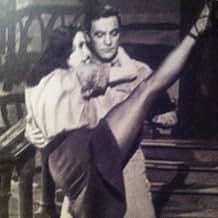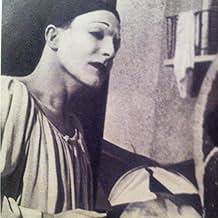IMDb-BEWERTUNG
6,4/10
1095
IHRE BEWERTUNG
Füge eine Handlung in deiner Sprache hinzuThree different stories are told through a notably unusual way - no words, just dance.Three different stories are told through a notably unusual way - no words, just dance.Three different stories are told through a notably unusual way - no words, just dance.
- Regie
- Drehbuch
- Hauptbesetzung
- Auszeichnungen
- 1 Gewinn & 1 Nominierung insgesamt
Luigi Faccuito
- Specialty Dancer
- (Nicht genannt)
Diki Lerner
- Thief in 'Sinbad the Sailor'
- (Nicht genannt)
Paddy Stone
- Speciality Dancer
- (Nicht genannt)
Ian Wilson
- Man Exiting Stage Door in 'Ring Around the Rosy'
- (Nicht genannt)
Empfohlene Bewertungen
In what must have been a daring move in the 1950s, Gene Kelly created a film which was pure dance - three sequences (Circus, Ring Around The Rosy, Sinbad the Sailor).
Although not a great grosser in its day, time has been kind to this film and although it is not that well known, this film should be as it has a large amount of charm.
The first section, Circus, is a story about a clown and his unrequited love for the leading lady. A common love triangle presented in ballet, this is bittersweet and watchable.
In Ring Around The Rosy, a bracelet is lost and found and there is a charming duet to watch ... while Sinbad the Sailor includes a mix of real life and animation in the story of the sailor and the genie.
As good as any of Kelly's other work, this should be seen a lot more than it is.
Although not a great grosser in its day, time has been kind to this film and although it is not that well known, this film should be as it has a large amount of charm.
The first section, Circus, is a story about a clown and his unrequited love for the leading lady. A common love triangle presented in ballet, this is bittersweet and watchable.
In Ring Around The Rosy, a bracelet is lost and found and there is a charming duet to watch ... while Sinbad the Sailor includes a mix of real life and animation in the story of the sailor and the genie.
As good as any of Kelly's other work, this should be seen a lot more than it is.
Gene Kelly was a visionary. He was passionate about his art and he was a master.
If you are passionate about your art and creativity, you will enjoy this celebration of dance. There is no dialogue to explain what is happening. There is no person telling you what to think. Kelly brings you to a moment and allows you to make the most of it.
Did you see love, pain, joy, desire, frustration, anger...congratulations!
If you are passionate about your art and creativity, you will enjoy this celebration of dance. There is no dialogue to explain what is happening. There is no person telling you what to think. Kelly brings you to a moment and allows you to make the most of it.
Did you see love, pain, joy, desire, frustration, anger...congratulations!
No wonder INVITATION TO THE DANCE found no audience at the box office. The first two musical sequences, "Circus" and "Ring Around the Rosy" are monumental bores dragged down by pedestrian stories and, in the second one, inept use of camera trickery to speed up the action.
But the third, "Sinbad the Sailor," makes expert use of the Rimsky-Korsakov ballet score and makes dazzling use of animated effects, especially for the dancing between Kelly and a couple of Arabian guards which are highly original, intricate and amusing examples of combining live action with animation. It's the kind of originality sadly missing in the previously mentioned stories.
The "Sinbad" highlight almost makes up for the rest of the film with its own brand of originality--but alas, the first two sequences are enough to turn many viewers away from watching the final segment.
Summing up: Easy to see why this one failed miserably to attract a target audience with either high or low brow tastes.
But the third, "Sinbad the Sailor," makes expert use of the Rimsky-Korsakov ballet score and makes dazzling use of animated effects, especially for the dancing between Kelly and a couple of Arabian guards which are highly original, intricate and amusing examples of combining live action with animation. It's the kind of originality sadly missing in the previously mentioned stories.
The "Sinbad" highlight almost makes up for the rest of the film with its own brand of originality--but alas, the first two sequences are enough to turn many viewers away from watching the final segment.
Summing up: Easy to see why this one failed miserably to attract a target audience with either high or low brow tastes.
Invitation to the Dance is what you get when you take an artist at the peak of his abilities and allow his imagination to run wild. Gene Kelly--and some very talented people in all fields--integrated music and dance to create three distinct stories.
He reduces some scenes to their visual essences by using abstract or minimalist sets, aided by lighting effects. The third story includes cartoons, allowing Kelly to take his imagination beyond the bounds of human limitations and physics.
The performances are a synthesis of various dance and related forms (ballet, tap, jazz, mime, acrobatics, pop, and ethnic) with musical accompaniment (classical, jazz--cool and hot--ethnic, and pop).
Invitation to the Dance is a treat for any dance lover. It should be seen by all young students of dance.
It would be interesting to see this film they way Kelly originally imagined it, with him dancing in one section only.
He reduces some scenes to their visual essences by using abstract or minimalist sets, aided by lighting effects. The third story includes cartoons, allowing Kelly to take his imagination beyond the bounds of human limitations and physics.
The performances are a synthesis of various dance and related forms (ballet, tap, jazz, mime, acrobatics, pop, and ethnic) with musical accompaniment (classical, jazz--cool and hot--ethnic, and pop).
Invitation to the Dance is a treat for any dance lover. It should be seen by all young students of dance.
It would be interesting to see this film they way Kelly originally imagined it, with him dancing in one section only.
It might better have been called "Invitation to the Pantomime" because there is no speaking, much less singing, in the film, a production much better suited to the stage. The movie does in fact look like a filmed stage production, and the format and ambitions of the film are not what audiences had come to expect from Gene Kelly. But this was his baby, and he wanted to take filmed dance to entirely new levels of artistic achievement. In many ways, it is a testimony to his power as a choreographer and a star that he was able to pull it off. Nevertheless, beautiful as it is, this is not everyone's cup of tea. Watching the first of the three dance sequences, I longed for Kelly to take that white paint off his mime face and stop mooning over the ballerina. He did, and the next two sequences are more enjoyable, the last being rather fun when animation takes over. ---from Musicals on the Silver Screen, American Library Association, 2013
Wusstest du schon
- WissenswertesGene Kelly's original intention was to make a film that would educate mainstream audiences about professional dancing in the world. To this end, he wanted to cast the greatest dancers in Europe for the four segments in leading roles. He himself would appear in only one - the Popular Song sequence, which ended up being cut. MGM, however, refused to allow the picture unless he appeared in all of them. Many of the professionals who worked in the film agreed that this was one of the film's great weaknesses.
- PatzerDuring the "Scheherazade" sequence, the color of the palace guard's costume changes from green to blue.
- VerbindungenEdited into American Masters: Gene Kelly: Anatomy of a Dancer (2002)
- SoundtracksCircus
Music by Jacques Ibert
Performed by The Royal Philharmonic Orchestra, conducted by John Hollingsworth
Danced by Gene Kelly, Igor Youskevitch and Claire Sombert
Top-Auswahl
Melde dich zum Bewerten an und greife auf die Watchlist für personalisierte Empfehlungen zu.
- How long is Invitation to the Dance?Powered by Alexa
Details
Box Office
- Budget
- 1.500.000 $ (geschätzt)
- Laufzeit1 Stunde 33 Minuten
- Seitenverhältnis
- 1.37 : 1
Zu dieser Seite beitragen
Bearbeitung vorschlagen oder fehlenden Inhalt hinzufügen

Oberste Lücke
By what name was Einladung zum Tanz (1956) officially released in India in English?
Antwort































